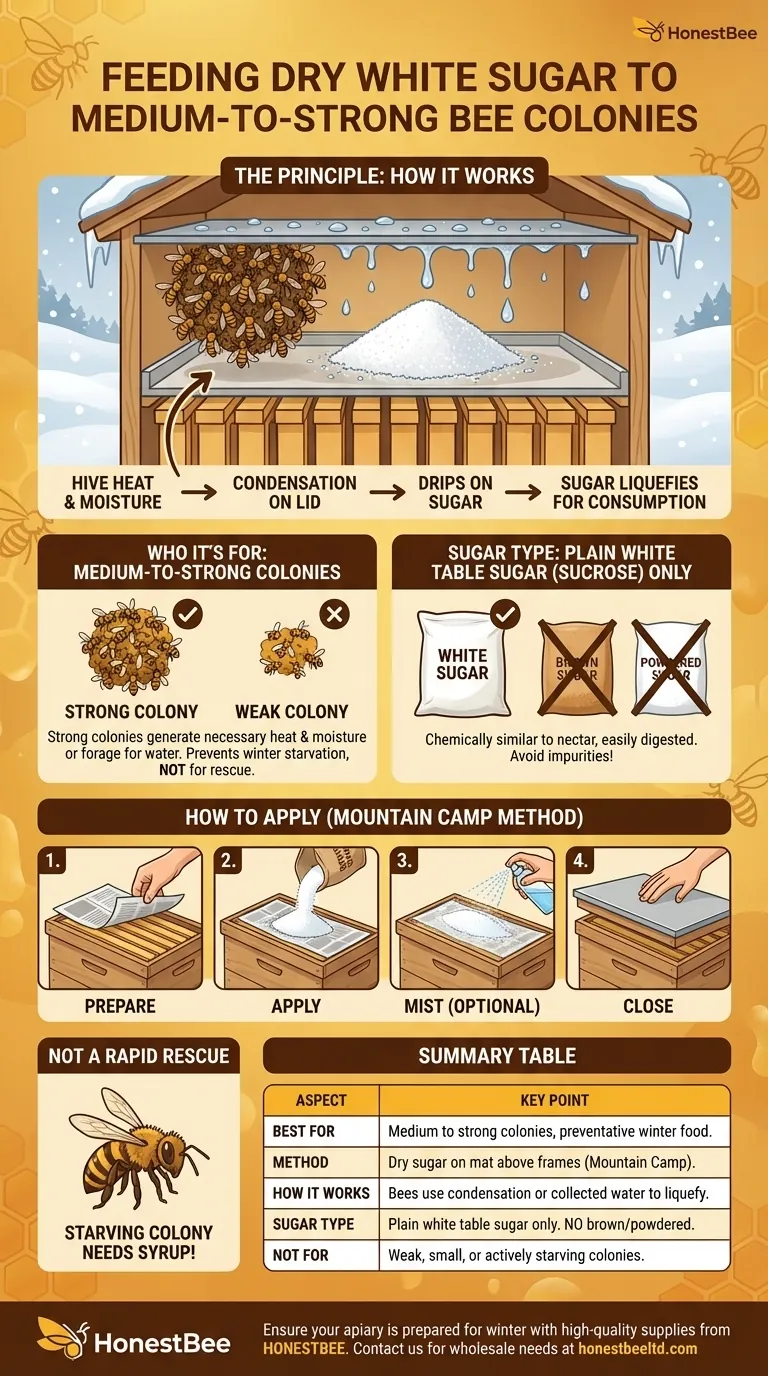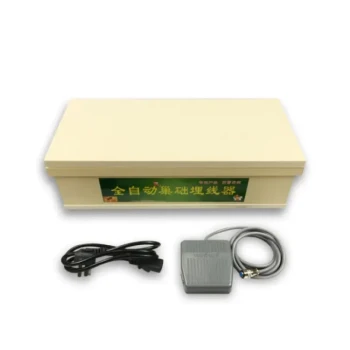To feed medium to strong bee colonies dry sugar, simply place a layer of plain white table sugar on a hive mat, tray, or a sheet of newspaper directly on top of the upper hive box's frames, underneath the main hive lid. The success of this method depends on the colony's ability to use moisture, either from condensation inside the hive or water gathered outside, to liquefy and consume the sugar crystals over time.
Dry sugar feeding is a slow-release, emergency feeding method primarily for preventing winter starvation in healthy colonies. It is not a rapid rescue for weak or actively starving bees, which require immediate liquid food like sugar syrup.

The Principle: How Dry Sugar Feeding Works
This method leverages a bee colony's natural behavior and the physics of the hive environment. It is a passive system that provides a safety net, not a primary food source during a nectar flow.
The Critical Role of Condensation
Bees generate significant heat and moisture through respiration and metabolic activity. In a cool or cold environment, this warm, moist air rises and condenses into water droplets on the cold underside of the hive's inner cover or lid.
When you place dry sugar directly below this surface, the condensation drips onto the sugar, dissolving it into a form the bees can easily consume.
The Colony's Contribution
This technique is only effective for medium to strong colonies for two reasons. First, a large population generates the necessary heat and moisture to create sufficient condensation.
Second, if condensation is insufficient, a strong colony has enough foragers to fly out on warmer days to collect water to bring back and liquefy the sugar.
Why White Table Sugar?
Use only plain white table sugar (sucrose). It is chemically very similar to the natural sucrose found in plant nectar and is easily digested by bees once liquefied.
Never use brown sugar, powdered sugar (which contains corn starch), or other organic sugars. These contain impurities or additives that can cause dysentery and harm the colony.
Understanding the Limitations and Risks
Dry sugar feeding is a valuable tool, but it is crucial to know when not to use it. Its effectiveness is entirely context-dependent.
This Is Not a Rapid Rescue
Dry sugar is a preventative measure, not an emergency intervention. A colony on the brink of starvation has no energy to process crystals; it needs immediately accessible food.
If you find a colony that is light, lethargic, or has its head in empty cells, you must feed them sugar syrup for a rapid energy boost. Once they recover, you can provide dry sugar as a supplemental food source.
The Danger for Weak Colonies
Do not feed dry sugar to a weak or small colony. They cannot generate enough internal heat and moisture to dissolve the sugar.
Furthermore, they lack the population of foragers needed to collect external water. Providing dry sugar to a weak hive is ineffective and wastes the critical time that should be spent giving them life-saving syrup.
How to Apply Dry Sugar
The process is simple and requires minimal equipment. It is often called the "Mountain Camp" method.
- Prepare the Hive: Place a sheet of newspaper, a specially-made feeding shim, or an inner cover with a raised rim directly on top of the frames of the uppermost hive body, right over the bee cluster.
- Apply the Sugar: Gently pour 2-4 pounds of dry white table sugar onto the newspaper or into the shim. Spread it out, but keep it directly above the cluster where the heat and bees are concentrated.
- Provide a Moisture Source (Optional): Lightly mist the top of the sugar with a spray bottle to give the bees a head start, but be careful not to make it a wet slurry.
- Close the Hive: Place the main lid back on top. The sugar pile will now act as both an emergency food source and an absorbent layer for excess hive moisture. Check every few weeks and replenish as needed.
Making the Right Choice for Your Colony
Your decision to use dry sugar or sugar syrup must be based on the colony's specific condition and your management goal.
- If your primary focus is winter insurance for a healthy colony: Dry sugar is an excellent, low-maintenance method to prevent starvation.
- If your primary focus is rescuing a weak or starving colony: You must use 1:1 or 2:1 sugar syrup for immediate, life-saving energy.
- If your primary focus is stimulating brood rearing in late winter or early spring: Sugar syrup is more effective, as it better simulates a natural nectar flow.
By understanding the principles behind each method, you can provide the right support at the right time, ensuring your bees are healthy and productive.
Summary Table:
| Aspect | Key Point |
|---|---|
| Best For | Medium to strong colonies as a preventative winter food source. |
| Method | Place dry white sugar on a mat/tray above frames (Mountain Camp method). |
| How It Works | Bees use hive condensation or collected water to liquefy and consume sugar. |
| Sugar Type | Plain white table sugar (sucrose) only. Avoid brown or powdered sugar. |
| Not For | Weak, small, or actively starving colonies (they need sugar syrup). |
Ensure your apiary is prepared for winter with the right supplies from HONESTBEE.
We understand that effective beekeeping relies on having reliable equipment and knowing the best management practices. As a trusted wholesale supplier for commercial apiaries and beekeeping equipment distributors, HONESTBEE provides the high-quality supplies you need to support strong, healthy colonies year-round.
Let us help you equip your operation for success. Contact our team today to discuss your wholesale needs and discover how we can support your beekeeping business.
Visual Guide

Related Products
- Rapid Bee Feeder White Plastic 2L Round Top Feeder for 8 or 10-Frame Bee Hives
- HONESTBEE Advanced Ergonomic Stainless Steel Hive Tool for Beekeeping
- No Grafting Queen Rearing Kit: System for Royal Jelly Production and Queen Rearing
- Beehive Handle and Frame Rest Cutting Machine: Your Specialized Hive Machine
- High Quality Honey Dehumidifier Dryer Thickening Machine for Beekeeping
People Also Ask
- What is the capacity of the round hive top feeder for syrup and pollen? A Guide to Targeted Apiary Support
- Can you dilute honey and feed it to the bees? Understand the Critical Risks and Safe Practices
- Do beekeepers leave honey for bees? The Essential Guide to Sustainable Hive Management
- Can sugar syrup contaminate the honey crop? A Beekeeper's Guide to Protecting Honey Purity
- What are the recommended sugar-to-water ratios for making sugar syrup for bees? Optimize Your Hive's Health



















